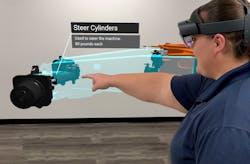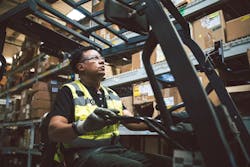"Digital transformation” is jargon. Companies don’t morph into entirely different organizations simply by adopting tools such as data analytics, virtual reality/augmented reality (VR/AR) and automated guided vehicles (AGVs). They can, however, become better versions of themselves.
“Since [the technology plan] came from business strategy, all of the executive leadership were involved, and we had high level buy-in completely,” says Khare. “The beauty of this framework is we do fewer projects, more impactful projects, more effective projects that solve real business problems.”
The strategic plan focused on trust in technology and trust in the teams that delivered it. “We said, ‘Forget about any new technology discussion—first we need to solve basic problems, make technology interaction friction-free,’” says Khare. “When we did that, employees would feel like, ‘Man, these guys are here for me.’”
Khare began with a small but important quality-of-life improvement for everyone across the company. “Several interactions with the service desk were automated through a chatbot. We made sure the time it takes to get a response from our service desk improved. We also empowered people through self-service,” he says. “There were tens of smaller steps like this which we took, which are tactical in nature, but they create the foundation for a strategic relationship.”
“Digital evolution” is what Khare is actually leading, an organization-wide effort to pave the way for new innovations and improved quality of life on the shop floor, changing the way one of the largest vehicle manufacturers in the United States operates. What follow are three examples of very cool projects Khare tills the corporate earth to make possible.
Predicting Supply Chain Reliability With AI
Our vision was a data-rich company. We’re in an unpredictable world, where the external world is unpredictable [and there are also] internal variables. How do you create predictability around that and be confident about your decisions? And that’s where we use descriptive analytics, predictive analytics and prescriptive analytics.”
ANUPAM KHARE, Senior vice president and chief information officer, Oshkosh Corp.
In-house data scientists at Oshkosh are using artificial intelligence to develop 25 different deep-learning algorithms, also called models, one of which focuses on supply-chain prediction.
“We have hundreds of parts that go into a particular vehicle, and those hundreds of parts come from thousands of suppliers,” says Khare. “That’s the magnitude we’re dealing with.”
Oshkosh breaks down into four business segments: fire and emergency, access (for instance, aerial platforms and material handlers), commercial (cement mixers and refuse trucks) and defense. Producing such a wide range of vehicles requires unique parts and processes, thus creating a complex supply chain.
“We’re pretty consistent about how we measure those suppliers and what’s important to us,” says Sean Ketter, vice president of Global Procurement and Supply Chain and a speaker at 2021’s IndustryWeek Manufacturing & Technology Show.
“Every single thing you can do to fix a supply chain shortage I’ve probably tried, or my colleagues have tried in some way,” Ketter continues. “The one thing that we never tried, or the one thing that we didn’t have the ability to do until recently, was the idea of using all the data that we’ve got.”
“We were confident that by taking all of our historical supplier performance information and part performance—things like on-time delivery, order quantity and percent shipped, parts that did not make the assembly line when we needed them—if we took all of that data, both pandemic and pre-pandemic, we should be able to generate an algorithm that can predict when a shortage will occur,” says Colton Vollmer, senior manager of digital supply chain.
In 2021, Vollmer and his team evaluated more than 2.5 million data points gathered since 2017 in an ERP system. It took about eight weeks to train a model to analyze the data and make predictions. The model now helps Oshkosh predict supply shortages before they happen, allowing the company to manage shortages with business processes.
“We’re now able to predict up to how many days late or how many days early our purchase orders from our suppliers are going to be to one of our facilities,” says Vollmer.
Downstream customers appreciate the heads-up. Plant teams adjust production schedules to make sure vehicles continue coming off production lines.
The trained model now requires only two months of data to make accurate predictions. And, Vollmer’s team is also considering what type of external data could complement the internal data that the model runs on to create a more robust model.
Virtual Training for Real World Safety
We never came up with a grand strategy. We came up with a bigger vision, but we … found champions [and said] let’s solve their problem—for example onboarding manufacturing employees through augmented reality and virtual reality.”
ANUPAM KHARE
Access equipment manufacturer JLG, an Oshkosh subsidiary, has for six years sold VR training units to customers that purchase boom lifts, providing safe training scenarios for employees who in the real world may go up to 185 feet in the air while riding in the lift basket. Three years ago, JLG began offering VR training units for scissor lifts.
The success of these offerings inspired confidence at JLG to design a newer, more complicated VR training program for internal use that Eric Mellott, senior manager for continuing improvement and operations training, runs out of the Operations Training Center in McConnellsburg, Pennsylvania.
“Think about the reduction on the stress of a trainee and the trainer. Some of these new hires, they’ve never been on a forklift before,” Mellott says. “And now they get on a forklift for the first time in virtual reality and not have any stress about ‘I’m going to hurt somebody or damage something.’ That’s both from a training and a trainer perspective. Our VR trainers love that they don’t have to be watching and stressful [in case] this new hire has an accident.”
“[VR] really helps us deliver consistent training, which produces consistent processes, which produce consistent quality in the real world on our production lines,” Mellott continues. “You can place a new forklift driver in a dozen scenarios [in VR] in about a one-hour time slot. If that person was to try to experience all 12 of those scenarios in real life, it could take weeks.”
The virtual trainers can then give feedback to hands-on trainers at the local plants where the new hires are posted—like notes on which trainees are ready for which operations and specific concerns for the hands-on trainers to watch out for in real life.
Three years ago, JLG acquired and explored the functionality of an AR welding training program, opening interest in further exploring the technology. Today, JLG offers an AR-based program to teach employees about line operations and the products that come off the line.
“It’s 100% interactive,” Mellott says. “They are pointing, they are clicking, they are walking around the machine, they are seeing basically our CAD model in front of them in augmented reality. They’re watching an assembly process, how the machine comes together.”
“I had [a trainee] take the headset off after about 45 minutes and say, ‘That’s a lot better than PowerPoint.’ That’s success,” Mellott says. “People are learning and engaging. You can’t sleep with an AR headset on. You can sleep through a PowerPoint presentation.”
Embracing Robotic Flexibility
“I never wanted, even if my business leaders align with what I am saying, for them to go in and kind of force something, because the whole principle here is building the trust with the technology and trust with the people. People need to see the benefit, that this is how it’s going to help their lives and their work.”
ANUPAM KHARE
When considering the roles that automated guided vehicles (AGVs) could play at Oshkosh plants, Don McCartney, vice president of Enterprise Architecture and Applications, says the company considered positive reception from employees just as important as return on investment.
“The question was, are our employees going to accept the technology as opposed to thinking that someone’s going to replace their job? So, we worked through how this technology was able to augment certain tasks,” says McCartney.
After this successful use case, Oshkosh decided it wanted AGVs with a little more intelligence and deployed a second variety that can circulate through a larger number of positions, have greater flexibility on the types of materials they carry and the intelligence to navigate around obstacles.
Quality-control testing on the AGVs—making sure they successfully move from point to point and deliver materials on time—generated data Oshkosh shared with plant employees to demonstrate that the AGVs were in fact increasing material delivery speed and removing plant delays.
“Then employees began naming them on the factory floor,” says McCartney. “Like, ‘Hey, Edgar, I need some parts!’”
Bandwidth and network hardware requirements for the wireless AGVs provided a technical challenge during installation, to make sure the vehicles smoothly received, processed and prioritized materials requests to get parts where needed and as quickly as possible. Oshkosh also had to make sure employees felt safe around driverless vehicles trundling through the plants.
Those initial two types of AGVs currently work in six plants across three business segments, with plans to expand their use to two additional plants by 2024. Ongoing data capture allows Oshkosh to continue refining materials delivery operations by analyzing AGV delivery times and determining optimal travel routes through the plants.
In 2021, Oshkosh deployed a third variety of AGVs: much larger vehicles that can carry entire vehicle frames; do not have specific, restrictive paths to follow; and can adapt to floor reconfigurations. These AGVs work in two plants, one in the commercial segment and one in the access segment, with planned expansion into a third plant.
Champions Lead the Way
“To be fair, I think, in my opinion, that our Midwest culture helps us. It is a very relationship-based culture. At every level we focus on trust and relationships. People want to work with people and whatever ideas they’re giving.”
ANUPAM KHARE
Oshkosh’s defense and commercial segments use the supply-chain analysis deep-learning model. Vollmer’s team also works on scaling the model for the fire and emergency and access segments, expecting the work to complete before the end of 2022.
“We measure things the same way— even though [they’re] different business units, different ERP systems, the data sources are all the same, which is really nice for us because our whole, entire supply chain can reap the benefits,” Vollmer says. “All the leadership supported this; it had really good visibility to everybody; [we gave] updates to vice presidents and levels on down.”
“All of our supply chain leadership focuses on quality, cost, delivery, compliance, innovation. So, when you have a model like this that is so integrally tied with one of your priorities—delivery—it’s not hard to get buy-in from almost every constituency you would have that’s affected here,” Ketter adds. “We had buy-in from all levels of the global procurement and supply chain organization.”
McCartney says an Oshkosh team is also developing an AGV concept that incorporates cobot, vision system, IIoT and AI technologies to help drive situational awareness of what’s happening on the shop floor, like noting locations where parts tend to fall onto the floor and driving efforts to improve parts storage at that location or measuring plant temperatures and noise levels to inform work-environment improvements.
“Now, these are forward-looking statements. But IoT is our digital eyes and ears on the shop floor. Why can’t we tap into those eyes and ears and determine additional improvements or get additional insights that we can provide back to our supervisors, that feed back into the analytics and back into the whole process?” says McCartney.
Adds Khare: “The only resistance we compete against is the attention of our people. They’re busy. So how do we help them? Anything we introduce requires some time before they start getting benefits. “But people are willing … I’ll say I’m pretty excited that we get the attention we ask for.”
About the Author
Dennis Scimeca
Dennis Scimeca is a veteran technology journalist with particular experience in vision system technology, machine learning/artificial intelligence, and augmented/mixed/virtual reality (XR), with bylines in consumer, developer, and B2B outlets.
At IndustryWeek, he covers the competitive advantages gained by manufacturers that deploy proven technologies. If you would like to share your story with IndustryWeek, please contact Dennis at [email protected].





